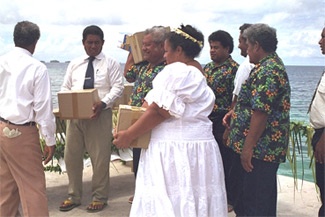|
|
The Kapingamarangi are a group of about 1,500 Polynesian people located in Micronesia. Half of the population live in a settlement on Pohnpei, while the other half live on the remote atoll, sixty miles north of the equator. A government ship provides transportation to and from the island every few months. In many people’s eyes the Kapingamarangi people may seem insignificant; however, their great motivation to have the Bible in their own language makes them an example to other language groups.
In 1982, the Kapingamarangi community contacted Wycliffe personnel and asked for someone to help them with Bible translation. For many years, there was no team available to help meet the need. But the request was not forgotten. Nico and Pam Daams, who worked with related Polynesian languages in the Solomon Islands, remembered it. In 1994, they visited Pohnpei. That was when one of the Kapingamarangi church leaders asked them, “What do we need to do to get you to come to help us?”
Two years later the Daams family arrived to help with the translation. Nico and Pam discovered the great commitment these island dwellers had for the Bible in their own language. For years the Kapingamarangi community had been saving money to pay for Bible translation, mainly by working copra or selling handicrafts. They had also been translating portions of scripture for the daily church services. Soon, twenty-four of these translators began work on the New Testament and nearly one hundred reviewers checked and commented on the translation. Nico worked with this team, providing training and exegetical expertise. Through their combined effort the New Testament was published in four years, with the Kapingamarangi community paying all the publication costs from the money they had saved all those years. The Kapingamarangi people felt such ownership for their project that when the question of paying the translators arose, their response was, “Why should we be paid? We are doing this for our own people. It’s our Bible!”
The translation team has continued work on the Old Testament. In 2004, forty percent of the Old Testament was published; they are now working on the remaining sixty percent. At the dedication of the published version, one man said, “The Kapingamarangi Bible has given our people new life.”
(This article is translated and adapted from an article that first appeared in “Volken & talen,” a publication of Wycliffe Netherlands.)


